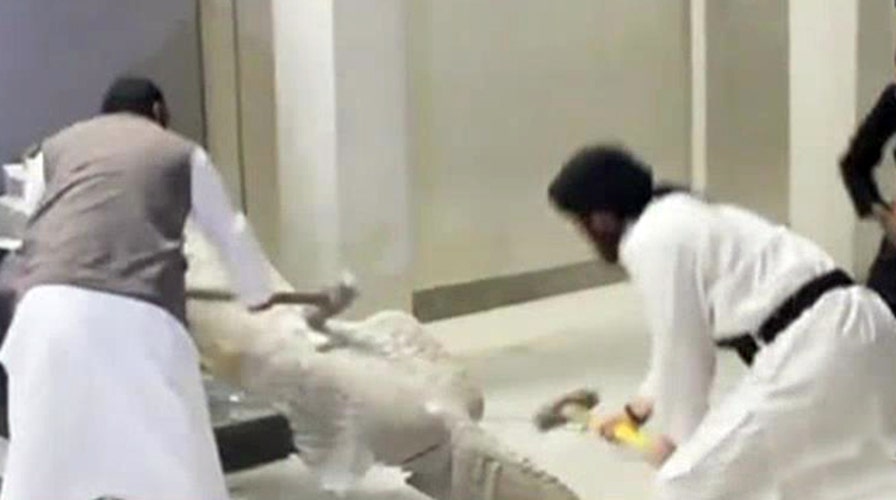Report: Video shows ISIS destroying Iraqi artifacts
Terrorists take sledgehammers to priceless relics in city of Mosul
Experts are using crowdsourced images and 3D printing technology in an ambitious project to recreate ancient artifacts destroyed by Islamic State in the Iraqi city of Mosul.
Last month ISIS released a video that showed militants using sledgehammers and drills to destroy artifacts in the Mosul Museum, the latest in a string of wanton attacks on sites of historic and religious importance.
Project Mosul, part of the European Union-funded Initial Training Network for Digital Cultural Heritage, is calling on volunteers to help restore the museum’s devastated artifacts.
“We need pictures of the artifacts found in the Mosul Museum,” explains the Project’s website. “These pictures allow us to digitally reconstruct the original artifacts, and can eventually aid in the restoration [of] those artifacts. The more pictures the better, and as many angles and perspectives, even better still!”
A host of Mosul Museum artifacts are listed on the Project’s website, including statues, steles, or stone slabs, reliefs, and ancient gates.
The fact that the Mosul Museum has been closed since the 2003 Iraq war makes the work even more difficult, according to the group, although it is confident that the crowdsourced images will deliver results.
“It is possible to reconstruct the artifacts and create digital surrogates,” it said. “This provides two immediate benefits: helping to identify looted items and recreating destroyed items.”
The Project has already started to recreate The Lion of Mosul statue from photos.
The Lion of Mosul by neshmi on Sketchfab
Researchers are also appealing for volunteers with computer coding skills who can help develop the Project Mosul Web platform.
Experts, however, are still debating the full impact of ISIS’ shocking actions at the Mosul Museum. Some media reports, for example, have said that many of the artifacts destroyed were fakes, although Christopher Jones, a graduate student in ancient Near Eastern history at Columbia University and author of the Gates of Nineveh blog, believes that a number of originals, particularly from the ancient city of Hatra, met their ends at the hands of ISIS.
“The Hatra wing of the museum was devastated, destroying many priceless works of art,” he explained in an email. “The Assyrian section was also damaged.”
Jones also cited a pair of winged bull statues, which stood at the ancient city of Nineveh’s Nergal Gate, as notable victims’ of ISIS’ twisted destruction. The terror group’s video clearly shows militants attacking the colossal statues with power tools and hammers at Mosul’s Nergal Gate archaeological site.
“The [winged bulls] at Mosul were some of the few which remained in their original location where they stood 2,600 years ago,” he said. “Many others that were excavated are now in museums in Baghdad, London, Paris, New York or Chicago.”
Experts predict that many of the museum’s contents have been looted, with anything small enough to be easily moved likely to be appearing soon on the antiquities market. ISIS militants are believed to have sold ancient artifacts on the black market in order to finance their bloody campaign across the region.
“Anything too large to remove for sale, appears to have met a violent end at the hand of ISIS extremists,” said the Project’s Mosul website.
“The video shows ISIS destroying statues that were either too large or too famous to sell on the black market,” added Jones. “Smaller items that remained in the museum were not shown in the video and may have already been sold.”
The expert noted that many of the museum’s smaller items were moved to Baghdad in 2003 for safekeeping.
ISIS jihadists have left a trail of devastation in their wake, destroying a number of shrines, including Muslim holy sites - in order to eliminate what they view as heresy.
The ancient archaeological site of Khorsabad, 9 miles northeast of Mosul, was recently ransacked by ISIS. The group has also razed 3,000-year old Nimrod and bulldozed 2,000-year old Hatra -- both UNESCO world heritage sites, in a move described by UN Secretary General Ban Ki Moon as a "war crime."
The Associated Press contributed to this report.
Follow James Rogers on Twitter @jamesjrogers





















